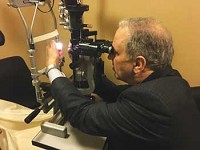By Matt Simonette

Submitted photo
Skokie-based ophthalmologist Stuart Sondheimer is one of many eye surgeons who travel the world helping underserved populations to see better, and he has asked some Northwestern engineering students to help lighten their loads.
Dr. Sondheimer has for five years been traveling on medical missions with the Santa Barbara, Cal.,-based organization Surgical Eye Expeditions (SEE) International. Founded in 1974, SEE organizes visits by eye surgeons to underserved areas around the world. According to the organization’s website, SEE surgeons have examined more than 3.6 million patients and performed more than 440,000 sight-restoring operations.
“There are hundreds of millions of people in this world that are blind from cataracts and pterygium and they don’t have to be,” he said. “In our country, when a patient has difficulty seeing to drive or read, we do cataract surgery, and we don’t even see much pterygium. …There are so many people going blind throughout the world, and they don’t have access to care.”
Recalling a recent trip to El Salvador, he said, “The average person there makes, eight or 10 dollars a day. Most of the ophthalmologists are in San Salvador, and in areas that are miles away, you have to get there and get back. You have to have money to pay the ophthalmologist, and you need to have some sort of hotel accommodations. All of these things make it impossible for many people to get health care.”
SEE International physicians bring mobile eye surgery facilities to residents in remote locations to ease both their access and costs. Dr. Sondheimer said he had gone on nine or 10 trips to nations such as Vietnam, Honduras, and Panama.
“In some of the places, we have a relatively modern facility we can work in, but other times, we bring in everything—operating microscopes, surgical and sterilization instruments, medications, intraocular lenses – and all of this equipment is donated,” he added. “We bring in a very crude operating room. In the United States, when I walk into a surgery center, I can have $750,000 worth of equipment helping me, but when we go to these poorer places, we bring things that cost just a pittance.”
Transporting the equipment takes money and logistical-planning as well, so SEE and its physicians are always looking for ways to lighten cargo and reduce costs. So Dr. Sondheimer and SEE officials asked Richard Freeman, Clinical Assistant Professor of Undergraduate Engineering at Northwestern University’s McCormick School of Engineering, to get involved.
Mr. Freeman teaches a course, Design Thinking and Communication (DTC), that encourages undergraduate engineering students to conceptualize projects with real-world applications. DTC students further learn skills such as interacting with clients and undertaking background research. Dr. Sondheimer asked Mr. Freeman’s students to develop a stand for a surgical microscope that would be lighter and easier to carry.
“Right now that load is about 80 pounds,” said Dr. Sondheimer. “We’re trying to get a way to get strong materials, where we can get the microscope where we need it to be, in a lightweight package, and put it into a suitcase. …Their challenge is to create a better stand that can hold the microscope, that can be sent throughout the world.”
Three teams of four freshmen engineering students, each working with a budget of about $100, are working on stands, said Mr. Freeman.
“What ends up happening is each team works on their own version. They’ll each put together a functional prototype in our shop, then it would be up to Dr. Sondheimer to get it manufactured,” he said.
The DTC courses are “cornerstone” classes intended to get engineering students involved in practical engineering applications earlier on in their college careers, rather than just waiting until senior year, when more traditional “capstone” courses take place.
“Ideally, if we can get this thing under 50 pounds, with the case, the operating microscope and the stand, then it can be taken on an airplane and can go to many different places without any special handling and charges,” added Dr. Sondheimer.
The students spend their class time and usually about nine or 10 hours a week outside the classroom working on the project. The prototype will be chosen at the end of the school year.
“We really appreciate SEE International and Dr. Sondheimer asking us to do this,” said Mr. Freeman. “If we can come up with something that actually works, we would be helping people to see, and that would be amazing. We want to inspire our students to think about creating solutions rather than just doing calculations.”

